Welcome to another Saturday, newly hatched. It is dark, and quite cool, and nipper slumbers beside me.
This week I seem to have had slightly more time, and used it, maybe not so wisely, but in many places, not just here in the newsletter. I did a bit of the Index, a couple of home pages for groups of sets, and also started extracting from volume one number one of the Cartophilic Notes and News, from way back in 1965, but with the idea of only extracting things relating to Branches, Clubs, and Conventions. So if you nip over to our Branch and Club pages you will note that there are some new names and also many more dates, which has allowed for branches to split into parts, mainly to denote the fact that, before 1965, four of them belonged to the Cameric Cigarette Card Club (these being London, Midlands, Yorkshire, and Lancashire - though not all of these are done). Doing this also allows us to celebrate every Branch, and Club, and gathering - so that collectors of today, in those areas, can see, instantly what used to be, they no longer have to hunt in other pages.
And so, to tonight`s newsletter, which I found very interesting to write. And thanks to everyone who assisted, by sending in cards, lists and little anecdotes. Remember these are your newsletters too; if they spark a memory we would love to hear it. Just as the Branch and Convention pages are yours, and they are all the more interesting for the personal and local reminiscing.
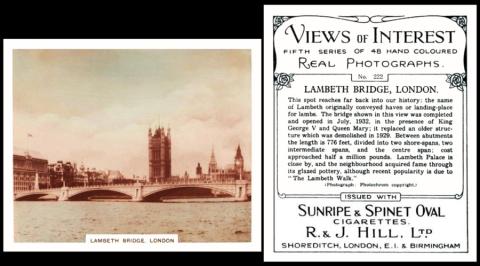
R & J Hill [tobacco : UK] "Views of Interest" - fifth series (1939) card 222 - H554-780.5 : H46-96.5
I was on the fence with this one last week, or maybe on the bridge, waiting to leap. The problem was that some places said that today in 1932 saw Lambeth Bridge, showing here, opened in a grand ceremony, but others say it was not until the 19th. And as I had a bit of time a few moments before the newsletter went to press, I did more research, which proved it to have been opened on to be the 19th. So this is the first newsletter I ever started writing before I published the one before! Not that it made me any quicker though.
Lambeth Bridge crosses the Thames between Westminster Bridge and Vauxhall Bridge. It is the second bridge on the site, but the third crossing, as there used to be a ferry, at this very location, which was replaced by the first bridge in 1862.
The bridge, immortalised on this card, was designed by British architect Sir Reginald Theodore Blomfield and civil engineer Sir George William Humphreys.
These sets, each of forty eight cards, were issued between 1938 and 1939, and four of the five series, but apparently not series two, were printed by the Rotary Photographic Co., prolific issuers of picture postcards.
We do not yet have a home page for this interesting group, but that will be sorted out when I use a card from the first series.
Our original reference book to the issues of R. & J. Hill (RB.2, published in 1942) tells us that the group comprises eight variations, including two subtitled "British Empire Series of 240 Cards" - namely a "Canada" and an "India". There were also a "Views of London", and "Views of the River Thames" (or five, if you count the back variations). These sets, of London, and the Thames, came earlier, in 1924 and 1925 - the "Views of Interest" started in 1938, and went through to our fifth series in 1939. After that, they started expanding in to the British Empire, but they did not get very far; in fact, of their planned 240 cards only 96 were ever printed, for the trip to India was being packed up, ready for sending out, when Hill`s premises, and all the cards that were waiting for the off, were completely destroyed by a bomb.
This, the fifth series, appears in our original R. & J. Hill reference book as :
- 1939. 48. VIEWS OF INTEREST. (titled series). "Fifth series of 48 hand coloured Real Photographs. Size 3 1/16" x 2 1/2". Numbered 193-240. Fronts, sepia toned photographs, glossy finished and hand coloured, with titles and white margins. Backs, printed in black only, with descriptions and inscribed "Issued with Sunripe and Spinet Oval Cigarettes, R. & J. Hill, Ltd., Shoreditch, London, E.1..."
Both the 4th and 5th series were produced by the Rotary Photographic Co. All cards in the above five series are views of the United Kingdom.
This amazingly detailed description of the fifth series is not carried over our original World Tobacco Issues Index. In there, it simply appears as :
- VIEWS OF INTEREST. Lg. 76 x 63 Hand-coloured photos. Special album issued. ... H46-96
5. Fifth Series ..." Nd. 193/240. (48)
The same text appears in our updated volume, but there is a new card code, of H554-780.

R. TWINING & Co. [trade : tea : UK - London] "Rare Stamps" - first series" (1958) 11/25 - TWI-070.1 - TW1-1.1
After my early start I was stymied by this one.
It started out as Ben Curtis winning the British Open Golf Tournament in 2003 but I could not find him on a card.
Then it went to Ice Cream Day, which I had almost finished when I had to answer a phone call, and the machine ran out of battery, and when I switched it back on I put in Ice Cream Day to find where I was and found, instead, that I had used it before as a diary date, in the newsletter for the 10th of December 2019 - as the card for Friday, 13th December.
But enough kvetching, as we now have something better, and that is the fact that today, in 1890, saw the first issue of Stanley Gibbons Monthly. Curiously, there was an [Edward] Stanley Gibbons, who started the company in 1856, but he sold it in 1890 to a Charles James Phillips, for £25,000. Which seems a huge amount. Mr. Phillips already had a stamp magazine, called "The Stamp Advertiser and Auction Record", but pretty soon that had gone and in its place was the "Gibbons Monthly Journal". This lasted until 1905, when it went to a weekly magazine. This only lasted for three years before he realised that it was all getting a bit too much, and he reverted to a monthly publication again in January 1911. That suited him better, and it only halted, forcibly, with the outbreak of the First World War.
This card is a good addition to our gallery, for we featured the second series, with the red overprint, elsewhere - as our Card of the Day for the 27th of November, 2023. That page also reveals who L.N. and M. Williams, named on the cards, actually were.
However this set we show you today is the scarcer first series, described in our British Trade Index part II as :
- RARE STAMPS BY L. N. & M. WILLIAMS. Sm. 68 x 36. Nd. Also issued in joined pairs. ... TW1-1
1. A series of 30
2. 2nd series of 30 (a) normal (b) overprinted in red “These cards will be withdrawn 31st December 1960”.
A plain printed card announces end of issue.
Our updated British Trade Index lists them slightly different, as :
- RARE STAMPS by L. N. & M. Williams. 68 x 36. Nd. (30). Folder issued with details of offer to send complete sets for a packet of Foreign stamps. ... TWI-070
1. 1958. A series of 30 issued a) singly b) in joined pairs
2. 1960. 2nd series of 30 a) normal b) overprinted in red “These cards will be withdrawn 31st December 1960”.
A plain printed card announces end of issue.

John Player [tobacco : UK - Nottingham] "Flag Girls of All Nations" (December 1908) Un/25 - P644-590 : P72-180 : RB.21/200-64.H : P.96 [RB.17/96]
Now this diary date was much easier. The first thing I wrote down was "Belgium National Day", and look, so it still remains. And it also fills a gap in our gallery, with yet another version of this set, though we still have not yet allotted it a home page as a Card of the Day!
Belgium National Day celebrates the day that Leopold I became the first King of the Belgians, in 1831. Before that, Belgium was part of the Netherlands. And, oddly, the first King of Belgium, Leopold George Christian Frederick, was a German, born in Saxe-Coburg. He stayed King until 1865 and then died, in office. In fact he was nearly the King of Greece, because when that country gained their independence in 1830, he was offered that very position, but he thought about it and turned it down. However the careful way that he weighed up the decision was remembered, and when the throne of Belgium came up he was offered the job first, and he accepted.
Leopold I himself appears on very few cards - in fact I only know of one set, by Liebig, entitled "Leopold I" and issued in 1957. The codes on that are F.1668 or S,1669. You are much more likely to find his medal, The Order of Leopold I, which card 38 of John Player`s "War Decorations and Medals" (issued in 1927) tells us he instituted in 1832, and which, since 1838, has been divided into five classes, civil and military. It also tells us that "Among recipients of the first class are : The Earl of Ypres, Earl Haig, Earl Jellicoe, and Earl Beatty." It also appears as one of Wills` silk "War Medals" (1916), where it is called "The Ordre de Leopold I" to the front, and, on the back, is described as "...an Order for Civil and Military Merit, instituted by his Majesty Leopold I in 1832".
This set is first recorded in our original John Player reference book, RB.17, published in 1950, as :
- 96. FLAG GIRLS OF ALL NATIONS. (adopted title). Small cards, size 63 x 36 m/m. Fronts per Fig.9 in colour. Backs in red, inscribed : "Smoke Player`s Navy Mixture. John Player & Sons., England". Unnumbered series of 25. Overseas issue, December 1908.
1. America
2. Austria
3. Belgium
4. Canada
5. China
6. Cuba
7. Denmark
8. Egypt
9. England
10. France
11. Germany
12. Greece
13. Holland
14. Ireland
15. Italy
16. Japan
17. Mexico
18. Norway
19. Portugal
20. Russia
21. Scotland
22. Spain
23. Sweden
24. Switzerland
25. Turkey
Similar sets issued by B.A.T., ("Motor" Cigarettes), Lambert & Butler, Wills, and Anonymous, plain backs.
By the time of our original World Tobacco Issues Index, six years after, this set is listed under section three of the Player issues, devoted to "Export Issues without I.T.C. Clause. Issued through B.A.T.". Section A of that is an odd one, it is headed "Issues 1908-1911, Chiefly in Malaya and Siam. Small size 63 x 37 m/m/ Backs in red, inscribed "Smoke Player`s Navy Mixture". However it contains only two sets, Drum Horses and our Flag Girls of All Nations.
Our set is described as :
- FLAG GIRLS OF ALL NATIONS. (A). Sm. Unnd. (25). See RB17/96 and RB.21/200-64.H ... P72-180
This remains the same in our updated volume but the card code has changed, to P644-590.

Produits CASINO [trade : supermarkets : O/S - France] "Les Fruits Exotiques" (1932) 152/??
Today, and every 22nd of July, is #NationalMangoDay. At one time these fruits were scarce outside the tropics, but these days they are quite easy to find in most supermarkets. They actually come from India, and they have been known there for thousands of years.
Curiously, most researchers think that the way they came to Europe was as seeds, not as fruits. But perhaps people took the risk and planted them because of the way they were described - the "King of Fruits", the "Bringer of Riches". It must have worked, as today the plants not only grow right around the world, but there are many different varieties.
Today we know they are healthy too, with more vitamin C than an orange, more potassium than a banana, and, if pulped into a drink, high in fibre.
One of the earliest cards of a mango comes as part of Allen & Ginter`s "Fruits" - but that shown is quite a small fruit, quite orange, and very round, and whilst some mangos are round, most are oval, and larger at one end than the other, and also they are frequently a mixture of colours, greens and reds with patches of yellow and orange.
As far as the issuer of this card, some collectors and dealers will list it as "Bon Marche", but in actual fact it was issued by Casino.
When I started writing this, I said : though this is card 152, I have not found any others anywhere. But since then I have asked about and I have found a few. But for now I will only list those - as they are very few indeed.
- 145. Ananas [pineapple]
- 146. Datte [date]
- 147. Banana [banana]
- 148. Noix de Coco [coconut]
- 149. Figue de Barbarie [prickly pear]
- 150. Papaye [papaya]
- 151. Fruit de l`Arbre a pain [breadfruit]
- 152. Mangue [mango]
- 153. Caroube [carob]
- 154. Calebasse [calabash]
- 155. Mangoustan [mangosteen]
Also once I got this, which is, oddly, complete from number 145 to number 155, I just kept hitting doubles, which makes me think it may be a sub section of just ten cards within a larger set. Can anyone confirm, or deny this?
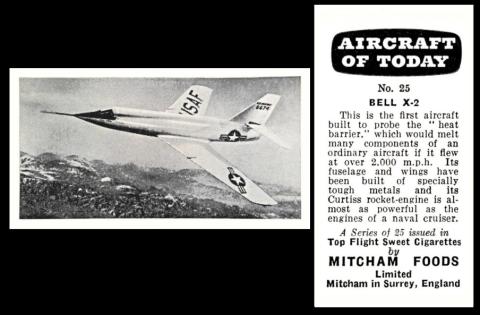
MITCHAM Foods Limited [trade : confectionery : UK - Mitcham, Surrey] "Aircraft of Today" (1955) 25/25 - MIT-030.a : MKE-1.a
Today, in 1956, this aeroplane, the Bell X-2, broke the record. In fact, as this card tells us, it was "...the first aircraft built to probe the "heat barrier", which would melt many components of an ordinary aircraft if it flew at over 2,000 m.p.h."
But let us go back a bit, because there was another series, the X-1, or XS-1. This was imagined in 1944 and built in 1945, and piloted by Chuck Yeager, it flew, in 1948, at nearly a thousand miles per hour.
The Bell X-2 was built to fly faster. The dream began in 1945, and it was primarily built to find a way through what is called on this card as the "heat barrier", but which was actually the rise in temperature associated with the speed, and altitude. So it was specially built in stainless steel and an alloy of copper and nickel, and its fuel was a mix of alcohol and oxygen.
It was also to be launched in mid air, dropped from a modified bomber. However the first flight, on June the 27th, 1952, failed. In effect, the aircraft exploded, killing not just the test pilot, but a crew member of the drop plane. The remnants of the X-2 aircraft fell into Lake Ontario, and were never found.
The first powered flight was undertaken by Lt. Col. Frank K. Everest on the 18th of November 1955, and he went on to make nine more flights over the next six months, taking the craft up to almost Mach 3 (1,900 m.p.h.), but he knew time was not on the side of the project, and that standard aeroplanes would be able to be developed to not much slower speeds in a much faster time frame. He also knew that the design was pretty much faulty, and though the boundaries were being endlessly pushed the craft was not up to the task, the steering and the controls frequently failed and then suddenly popped back in again as the craft came down and the speeds and G Force reached a limit they could cope with. Maybe he told them, maybe he just pulled out, but two new pilots were assigned.
Captains Kincheloe and Apt started work in 1956. At first they tested the height limits, reaching 126,200 feet later that year. But it was Captain Apt alone who hit Mach 3.2 on the 27th of September, launched from a bomber, as the ill fated X-1 had been, only to find, shortly after he had set the record, that his instruments send him into a series of uncontrollable rolls and spins. He just had time to press the ejection capsule, but not time to deploy the parachutes before it hit the ground at full speed. The aircraft flew on for five miles, and broke up on impact. There were plans to salvage it, rebuild it, and try again, but they were not approved and the whole project was scrapped.
Now since using this card I have been able to correct some common misconceptions about it. Many collectors think there are two sets, which there are not, however there are two printings, described in our original British Trade Index part two as :
- AIRCRAFT OF TODAY. Sm. 63 x 34. Nd. (25). Back (a) with (b) without "Top Flight Sweet Cigarettes" above firm`s name. ... MKE-1
Now as I have been able to see both versions I can tell you (until I show you one, possibly later on today) that the two backs read :
| version a | version b |
| A Series of 25 issued in | A Series of 25 issued by |
| Top Flight Sweet Cigarettes | MITCHAM FOODS |
| by | LIMITED |
| MITCHAM FOODS | MITCHAM IN SURREY, ENGLAND |
| Limited | |
| Mitcham in Surrey, England |
This is explained a lot better in our updated British Trade Index, as :
- AIRCRAFT OF TODAY. 1956. 63 x 34. B&W. Nd. (25). Back a) with b) without "Top Flight Sweet Cigarettes" above firm`s name ... MIT-030
The full line up of the sets is as follows :
1955 set :
- Vickers Valiant B, Mk. I
- Convair XF2Y-1 Sea Dart
- S.O. 9000 Trident
- Lockheed Super Constellation
- Hiller "Flying Platform"
- Avro Vulcan B. Mk. I
- Douglas A4D-1 Skyhawk
- Westland S-55
- Bell V.T.O.L.
- Boeing B-52A Stratofortress
- Lockheed C-130A Hercules
- Vickers Viscount 701
- Hawker Hunter F.Mk.I
- Convair F-102A
- Martin XP6M-1 Seamaster
- North American F100 Super Sabre
- De Havilland Comet 3
- Scottish Aviation Twin Pioneer
- Fairey Delta 2
- Bristol Britannia 100
- Blackburn and General Aircraft Beverley C.Mk.I
- Handley Page Herald
- De Havilland Heron Series 2
- De Havilland D.H.110
- Bell X-2
Unfortunately I am still hunting a checklist for the 1960 set. But watch this space
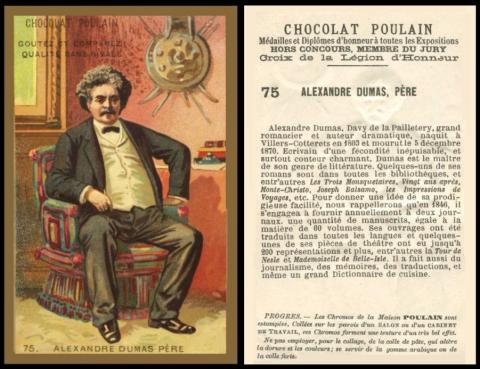
Chocolat POULAIN [trade : chocolate : O/S - France] "Celebrites" - embossed (19) 75/??
A spot of literature now, as today, in 1802, saw the birth of Alexandre Dumas, in Picardy France, in 1802. However, his father, who would rise to become General Thomas-Alexandre Dumas Davy de la Pailleterie, was born in what was then called Saint Dominique, a French colony, that we know today as Haiti. His father was a nobleman, and his mother a slave. His father also had two daughters with the same lady, and you would think that this would have made him think more kindly of other nations, and embrace tolerance, but there are some uncomfortable moment in his books when they are read with modern sensibilities. In addition, though the father had all those names, Alexandre was simply Alexander, and not even the "Dumas", he just took that, in the absence of anything else.
When Alexandre was fourteen his father took him to France, without the daughters, and left him at a military school. He seems to have stayed there until he graduated, at which time he decided he did not want to follow that choice of career and got a job as a writer with the Duke of Orleans. Some say that this job was mainly because the Duke knew of our man`s father, or thought he would get to know him better. During this period he published most of the books that we know him for today, starting with La Comtesse de Salisbury in 1839, and moving through The Fencing Master, The Corsican Brothers, The Count of Monte Cristo, and the various works in the Three Musketeers series.
During this time, he married an actress, nine years younger than him, whose stage name was Ida Ferrier. They had no children together, but he had at least four, and a succession of mistresses, sometimes more than one at the same time. One of these children was Alexandre Dumas fils, or son, which is why we have the pere on this card.
However, when Napoleon Bonaparte was elected in 1851, Alexandre Dumas decided to leave, and he moved to Belgium. the reason behind this was that Alexandre Dumas had been a supporter of the de-throning of King Charles X and had helped to install his former employer, the Duke of Orleans, as ruler in his stead. He may have moved to Belgium, but in fact he travelled quite a lot during the next decade, and turned many of his trips into what we would consider travel books. Some of these may weave a fictional tale into them, but primarily they are reports of the things he saw along his way.
His wife died in 1859, and a couple of years after that he found himself in Italy, where he seriously thought of settling down - in fact he started a newspaper whilst he was there, but suddenly, in 1864, he returned to Paris.
Not much is known of that time of his life, but in December 1870 he died, we do not really even know how, though there is much speculation about him having a heart attack However his death certificate is for natural causes. He was sixty-eight years old. He was originally buried in the town of his birth, but in the year 2002 the French President, Jacques Chirac, ordered that he be dug up and reburied at the Pantheon in France. This led to public outcry, but the deed was done, and the re-burial televised.
It seems rather odd that most card sites give but one card for him, number 24 of Ardath`s "Your Birthday Tells Your Fortune" (issued in 1937). And that calls him Alexander. You can find him on a Guinea Gold, though - Series C No.286.
He does much better in Europe, with Liebig devoting complete sets to The Three Musketeers (F.0675 : S.0673 - 1901) and The Count of Monte Cristo (F.0696 : S.0697 - 1902). But do note that the oft quoted card 292 of Guerin-Boutron`s "Celebrites Contemporaines" is of his son, for the caption says fils and not pere.
This set is quite elusive, and so far I only know of
- 30. Horace Vernet
- 75. Alexandre Dumas, pere
- 94. Littre
- 86. Lannes
- 157. Newton
So if you can add some, please do.
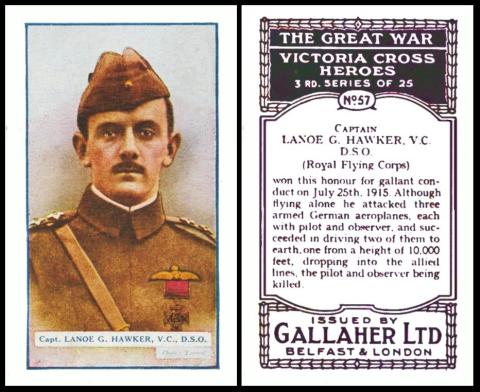
Gallaher Ltd. [tobacco : UK - London & Belfast] "The Great War - VC Heroes 3rd Series (1915) card 57 - G075-170.3 : G12-20.3
Today in 1915, this man, Lanoe Hawker, performed the deed that led to him becoming the third pilot to be awarded the Victoria Cross.
He had been born on the 30th of December 1890 in Hampshire. Strangely the Lanoe (which, if the ink is light on the card can be mis-read as Lance) was part of his mother`s name as she was a Lanoe-Hawker. And, even odder, his father was a Hawker too. However her father is definitely recorded as Major Peter William Lanoe Hawker, of the 74th Highlanders, but some digging has revealed that his mother and father were cousins, albeit geographically removed, his parental line being from Australia.
When our man was eleven he was sent to the Royal Naval College in Dartmouth. He was not so keen on the sea, and so he was rather glad to be diagnosed with jaundice. They moved him on to the Royal Military Academy at Woolwich, and a posting to the Royal Engineers. The interest in aircraft was suggested by more than a few popular flying films and by a display at Bournemouth. He arranged for lessons, up at Hendon, and passed his test quite quickly.
In the stirrings before the First World War began, he applied to join the Royal Flying Corps. This was allowed, and he was doing basic training even before the War broke out. By October 1914 he was a Captain, and had been posted to serve in France.
He was rather a daring flier, and was awarded the D.S.O. in April 1915 for a raid on a zeppelin field. The same month he was wounded in a freak incident, which saw him shot in the foot as he flew over the trenches; perhaps because he was flying too low. He was hospitalised, but downplayed the incident, and thereafter had to be carried to and from his aeroplane by his men. There may have also been some enforced no flying time, as he was a keen engineer, and found someone amongst the crew who joined him in his tinkering. This is perhaps not the right word, as he is reported to have modified several of the aeroplanes and their weaponry with good effect, so much so that many of his changes were adopted by the Royal Flying Corps.
His Victoria Cross was the result of downing three enemy aeroplanes, one after the other in July 1915. He therefore became the third military pilot and the first fighter pilot to receive the Victoria Cross.
By the time he returned to England towards the end of the year he was pretty famous. He was raised in rank to a Major, and given a squadron of single seater fighters, and pilots, which he trained on site in England then took back to France in February 1916.
There were already stirrings of not allowing the leaders to take part in the actions, and this came into force a few months after. However, Major Hawker agreed with one hand and ignored it totally otherwise. And so it was that on the 23rd of November, 1916, that he was killed. The German squadron was larger, and the advice was to report back not engage, but Major Hawker suddenly veered off in pursuit. It ended up as a personal battle between his aeroplane and another, which just so happened to be piloted by Manfred von Richthofen. the Red Baron. Major Hawker`s aeroplane was weaker in weaponry and smaller in engine, and he ought to have called it quits, but he took it to the limit of his fuel before he retreated and he was killed instantly by machine gun fire.
His body was recovered, and buried, but the site was not recorded, and the frequent damage to the area rendered it impossible to find again. And so his name is simply incised into the Arras Flying Services Memorial, one of too many pilots whose last resting places are not known.
Poignantly, it also looks like this is his only appearance on a cigarette card, and it has very little background about his life; it purely recants the incidents on that fateful day which set him up to be awarded the Victoria Cross. And less than a year after it was issued, he was gone.
Our set, the third series, is first described in our original Gallaher reference book (RB.4, published in 1944). In total they ran to an eighth series, with the last card being No.200.
Two hundred people, most of whom never knew they had been awarded the Victoria Cross at all, for they died in the action for which they won it, or succumbed, slowly, to their wounds, somewhere, away from all the things they held dear. Most never had wives, or sweethearts, and few had children.
And, for the most part, like our man, their winning of the Victoria Cross is the only way we know they existed at all.
The heading for the entire set reads :
- 1915. 25 THE GREAT WAR VICTORIA CROSS HEROES. (titled series). Size 2 1/2" x 1 1/2" approx. Numbered 1-25. Fronts printed in colour in letterpress from half-tone blocks, blue marginal lines, white margins, and titles inset in white panels. (Head and shoulder studies showing V.C.s), Backs printed in violet with descriptions and "Issued by Gallaher Ltd, Belfast & London"
Cards can be collected with the backs printed in various shades of purple, mauve, and violet.
Whilst he listing for our set is :
- THE GREAT WAR VICTORIA CROSS HEROES. (titled series "3rd Series of 25"). Numbered 51-75. Other details as above, but different subjects.
By the time of our original World Tobacco Issues Index much of the description was gone, in order to keep the book to a manageable size. The description there reads :
- THE GREAT WAR VICTORIA CROSS HEROES. Sm. See X1/Ha. 492.3A. .. G12-20.
3. "3rd Series". Nd 51-75. (25)
This too remains the same in our updated volume, but there is a new card code, of G075-160
This week's Cards of the Day...
joined in, sang along, and waved a few flags with the Promenade Concerts, which start on the 18th of July and run through to the 13th of September, eight weeks in all.
However many of the events are now sold out, as booking opened the second week in May - something to remember if you want to attend next year.
Our first card was :
Saturday, 12th July 2025
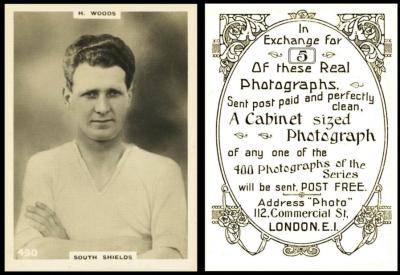
Here we have H. Woods, which ought to have suggested Henry Wood, or, more correctly, Sir Henry Joseph Wood, who conducted the Promenade Concerts for almost half a century, starting on the 10th of August 1895, and ending in 1944. He was so associated with them that after his death. later that year, they were officially renamed in his honour as the Henry Wood Promenade Concerts.
As for our man, Harry Woods, he was born in 1890 at St. Helens in Merseyside, and his first football team was the local one, St Helens Recreation. He trained as "a glass worker", which needs more investigation. He played for a couple more local sides and then, in 1911, was signed by Norwich City, where he played until the start of the First World War.
He must have had some mechanical experience as it is said he served in the Tank Corps; though he must have done something before that, as the first use of a tank was in September 1916 during the Battle of the Somme, and only then did the Tank Corps begin, as the Royal Tank Regiment which was, at first, joined in as part of the Machine Gun Corps. This suggests he may have started his career in an artillery unit, as it was primarily from those that the crews were selected.
When he was demobbed, and football had resumed, he moved to South Shields, which is the team he represents on this card. His first match for them was in August 1919. However, he did not stay there long, and in January 1922 he was bought by Newcastle United. This means that we can tie this card down to having been issued some time in 1921. He also did not settle at Newcastle, and joined Arsenal in August 1923. He fared better there, but was overshadowed a bit by younger, fitter, players - and in 1923 he was thirty-three years old. He then shifted to Luton Town, where his experience counted for more, but ended his career in 1930 with North Shields.
There is no record of what he did in the Second World War, all I have discovered is that he died in 1956, in his mid sixties.
This is the home page for the large sized "Pinnace" footballer photo cards. (You will find the home page for the smaller sets elsewhere, once I have written it).
Briefly "Pinnace" was a brand name, and it started including small photos of footballers, measuring about 45 x 35 m/m, in 1922, which could be exchanged for “a cabinet sized photograph" of players or teams. For a while it was thought that these larger cards may have been what that meant, but if you look at our card it is running the same offer, to swap five of these for a "cabinet sized photograph".
The larger, or “premium” cards are described in our original Godfrey Phillips reference book (RB.13, published in 1949), as :
- 81.B. Large Cards, size 83 x 59 m/m. Number issued unknown.
1. "Oval" design back, in black
2. "Single lined oblong" back, address "PINNACE" PHOTOS, in black. Fronts : -
(a) Player`s name at head, team at base
(b) Player`s name at base, no name of team, Some cards have printed slips surcharged on back with name of team.
(c) Player`s name and team at base
By the time of our World Tobacco Issues Index, this has been altered, to :
- FOOTBALLERS (A). Lg. Selected numbers only issued. ...P50-46
1. Back style 1, in black
2. Back with "Double-lined Oblong", address "PHOTO" or "PINNACE" PHOTOS.
3. Back with "Single-lined Oblong"
In the updated version of this volume, there is some additional information, namely :
- FOOTBALLERS (A). Skipped numbers in most printings. ... P521-290.
B. Large Size. All believed to be skipped numbers.
1. Back 1 - "Oval" design, in black.(?514)
2. Back with "Double-lined Oblong", address "PHOTO". (?852)
3. Back with "Double-lined Oblong", address "PINNACE" PHOTOS. (?2461). Some with player`s name only at base, or player`s name and team reversed.
Not sure what happened to the "Single-Lined Oblong" in this volume? Any ideas..?
Sunday, 13th July 2025
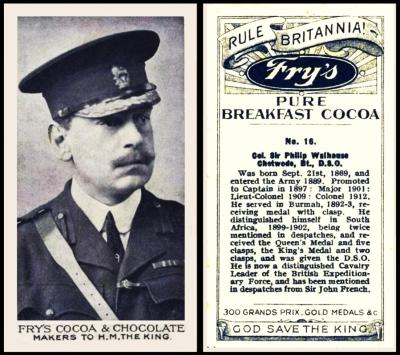
This card is included not for the person on the front, but for the "Rule Britannia" on the reverse, for that, for many years, was the song which was most connected with the Promenade Concerts.
And despite some controversy, it remains so to this day.
Strange then that it did not start its life as music at all, but as a poem, written in 1740 by James Thomson. However it was soon set to music, by Thomas Arne, to serve as the closing refrain in his theatrical production of "Alfred". This, a musical comedy about Alfred the Great, seems an odd idea, but it seems to have been much enjoyed by George I, to whom it was first performed, at his son`s home, Cliveden, in Berkshire.
The version which was performed at the Proms was actually arranged by Sir Malcolm Sargent. However, as times have changed it has fallen into disrepute, for its links with the Far Right, and also its celebration of colonialism and slavery. There have been many calls to remove it from the schedule, and actually it was removed in 1969, along with "Land of Hope and Glory". But it was reinstated the following year. And in 2020 it was only played as an orchestral piece, not sung.
Anyway, to our card, and here we have Field Marshal Philip Walhouse Chetwode, or 1st Baron Chetwode, or even Field Marshal the Right Honourable the Lord Chetwode.
He is shown here in 1915, but his military career was much longer than just the First World War, at which time he was almost fifty, for he was born on the 21st of September, 1869. His first overseas actions came in Burma, in the early 1890s. and he fought during the Second Boer War, being present at the Siege of Ladysmith, as well as many other strategic battles, and winning the Distinguished Service Order, one of his many medals.
During the First World War he found himself on the Western Front, and then sent to Palestine, from where he fought throughout the region, ending up at the Battle of Jerusalem in November 1917. After that, he was still in demand, and, after a spell in Aldershot, which did not really suit him, he was transferred to India, where he ended up as Commander in Chief.
He stayed there until the mid 1930s, then returned to England. For a short while he was even in charge of the Tower of London. He died, aged eighty-one, on the 6th of July, 1950.
Sadly his son had been killed in action in August 1940. Whilst his daughter, as those readers with an interest in poetry may already know, had married John Betjeman.
Our original British Trade Index lists this set as :
- RULE BRITANNIA ! Sm. 65 x 36. Steel blue. Great War Leaders and Warships. Nd. (25) … FRY-13
Whilst our updated version adds the date, and reads :
- RULE BRITANNIA ! 1915. 65 x 36. Steel blue. Great War Leaders and Warships. Nd. (25) … FRY-320
I am not entirely sure whether that is the title, or just an exhortation on what was intended to be perhaps just a military series. And I am curious as to the fact that it comprises leaders and warships. However I have not seen enough of the set to offer any opinions yet.
Monday, 14th July 2025
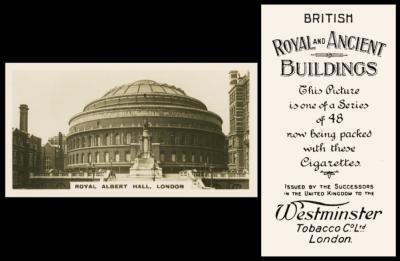
Here we have what most people regard as the permanent home of the Promenade Concerts.
But, as we will reveal, it was not always so.
When they began, they took place at Queen`s Hall, Langham Place, and even then they were but a development of the earlier concerts which had been regularly staged in several London parks and gardens for over a hundred years. In fact the name "promenade" refers to the idea that whilst the general public could sit and listen, they could also casually stroll about the park, with the music in the background.
The concerts at Queen`s Hall changed this, in many ways. For one thing, the audience had to pay to go in, a shilling for each concert, or you could pay a guinea and attend as many nights of the season of forty-nine concerts as you liked. You could not walk past and listen without paying. And it was also felt that if people paid, they would be more attentive, or less likely to interrupt the proceedings by chattering to their friends.
The Promenade Concerts stayed at Queen`s Hall until the Second World War. Then on the first of September 1939, Beethoven`s Second Piano Concerto was abruptly halted and the audience were informed that Poland had just been invaded. That may have been the end of the season for that year, as the BBC stepped down from supporting it - but Henry Wood was made of sterner stuff and he continued the run with the help of private backers, as well as some of his own money. And he also continued to play through an air raid on several occasions, even, on the 26th of August, 1940, extending the performance, for some while, until the "All Clear" was sounded and the audience were allowed to leave, which was not until the following morning. In fact this was the first time that the audience were encouraged to sing along with all their might. But that season was eventually abandoned when the raids became too intense.
The end of Queen`s Hall also came by bomb, on the 10th of May, 1941. That was when the concerts relocated to the Royal Albert Hall. They did move out, briefly, to the Bedford Corn Exchange in 1944, but when hostilities ceased they returned to the Royal Albert Hall, where they are still going strong today.
Its first appearance on cards is often said to be part of the 1902 Ogden`s "General Interest" series E, card 75, because it is billed as simply "Albert Hall". However Cohen, Weenen & Co`s "Interesting Buildings and Views", which also uses that title, was issued in the very same year - and, even if not the first card, it is definitely the first card to show the building in colour.
This picture is almost identical to the one used by R. J. Lea in their "Famous Views", issued in 1936, except that you can see more of the steps in the Lea version, for it is a bigger format card.
Westminster is a strange issuer. They were associated with both the Imperial Tobacco Company and British American Tobacco, which is how the first appearance of this set comes in our B.A.T. booklet, where it says they are in two formats, one being unnumbered with no descriptive text, and the other being numbered with a descriptive text. There was also some connection with the South African triumvirate of African Tobacco Manufacturers, United Tobacco Companies, and Policansky Bros.
Also, though their first cards were issued in 1914, they did not issue cards in the United Kingdom until 1925, which is why in our original World Tobacco Index they are not listed until part 4 of the Westminster section. In fact, by that time, they were not really Westminster cards at all, for, in the heading to that section, they are described as : "4. UNITED KINGDOM ISSUES. Inscribed "Issued by the successors in the United Kingdom to the Westminster Tobacco Co., Ltd. Co. London." Whilst the text for our set reads :
- BRITISH ROYAL AND ANCIENT BUILDINGS. See RB.21/200-159 ... W42-56.
1. First 48 subjects - (B) Numbered (C) Unnumbered.
2. Second 48 subjects, inscribed "A Second series". Nd.
In our updated version, the text reads :
- BRITISH ROYAL AND ANCIENT BUILDINGS. See RB.21/200-159 ... W430-840
1. First 48 subjects - (B) Numbered (C) Unnumbered.
2. Second 48 subjects, inscribed "A Second series". Nd.
I glossed over the "See RB.21/200-159" with good reason, as it turns out this set is more complex than I had imagined. The text there also reveals that there is a reason why there is no (A) above and the numbered is logged as (B) with the un-numbered version as (C).
The full entry reads :
- 200-159. BRITISH ROYAL AND ANCIENT BUILDINGS. The Wills printing only of this series is recorded in W/159. All the printings are detailed below, and the five different backs are illustrated at Fig.200-159 :-
I - First 48 subjects
A. Wills` Overseas issue. Back A
B. Westminster issue. Back B. Numbered, inscribed "Issued by the successors.....". Not inscribed "A Series of 48"
C. Westminster issue. Back C. Unnumbered, see listing below
II - Second 48 subjects
X. Westminster issue. Back X. Numbered, inscribed "A Series of 48", not inscribed "Issued by the successors.....".
Y. Westminster issue. Back Y. Inscribed "A Second Series"
As far as the Wills version, that was an overseas issue, and is detailed in part four of our Wills reference book as :
- 159. BRITISH ROYAL AND ANCIENT BUILDINGS. Fronts : Photoprints in black and white. Backs in black, with descriptive text. Issued in New Zealand between 1925-30. Similar series issued by Westminster (1st Series)
Then there is a list of the unnumbered cards which may be pertinent to our set but which i will have to delay adding for now.
Later on, in 1936, as part of the Wills "Works Magazine" it was revealed that this set was actually printed in the United Kingdom and shipped to New Zealand, where it was issued in packets from August 1925.
And if you want to see the second series of this set, nip along to our Card of the Day for the 15th of September, 2023
Tuesday, 15th July 2025
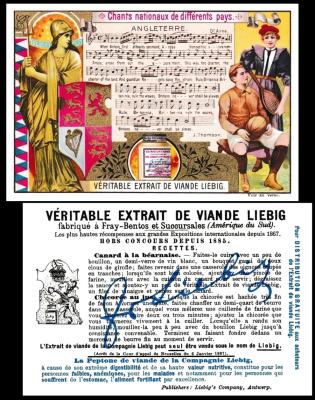
Here we have another card showing "Rule Britannia", and giving the music and lyrics. It also mentions the writer, Dr. Arne, or Thomas Augustine Arne, who was born in 1710. And J. Thomson, who is James Thomson, who was co-writer of "Alfred", the musical comedy about Alfred the Great that we spoke of yesterday.
The strange thing is that this set is universally regarded as being National Anthems. Even the title of our version of the set, which is in French, is titled as "Chants Nationaux de Differents Pays" - or National Songs of Different Countries". Whilst the German version is "Nationalhymnen Verschiedener Volker" - or National Anthems of Different Peoples.
Yet our anthem, at the time this set was issued, and as far back, perhaps, as the seventeenth century, is "God Save The King", not "Rule Britannia". Though it had neither words nor a Kingly connotation until 1745, and it was not called the National Anthem until the early 1800s.
Even more curious is that it is not our official National Anthem, because in legal documentation we do not actually have one. This is why there has been several occasions where either William Blake`s "Jerusalem" or Edward Elgar`s "Land of Hope and Glory" have been suggested as becoming the National Anthem. And both of these tunes also have a long association with the Proms.
This set is actually often referred to as "National Anthems II", which set me off on a quest to find the first series. And I think it is set 90, but that was issued some time earlier, between 1878 and 1883. It comprises eight cards, and was published in French, as "Chants Nationaux",, or in Italian, as "Inni Nazionali". The countries there are : Austria, Belgium, England, France, Italy, Russia, Spain, and USA. And in that set the England National Anthem is actually given as "God Save The Queen".
The list of countries in our set are as follows :
| English trans. | French | German | Writers listed |
| Austria | - Autriche | - Oesterreiche | - Joseph Haydn / L Haschka |
| Belgium (La Brabanconne) |
- Belgique | - Belgien | - Campenhout |
| Denmark | - Danemark | - Daenemark | - Kemp |
| England | - Angleterre | - England | - Dr. Arne / J.Thompson |
| France (La Marsellaise) |
- France | - Frankreich (Marsellaise) |
- Rouget de Lisle |
| Germany | - Allemagne | - Deutschland | - Henry Carey / Heinrich Harries |
And if you look closely at the card, there is also a sporting connotation as the female figure has a tennis racquet and the male figure a ball, which looks more like a rugby ball than a football. However I wonder how many tennis and rugby collectors have this card in their collections - yet.....
Wednesday, 16th July 2025
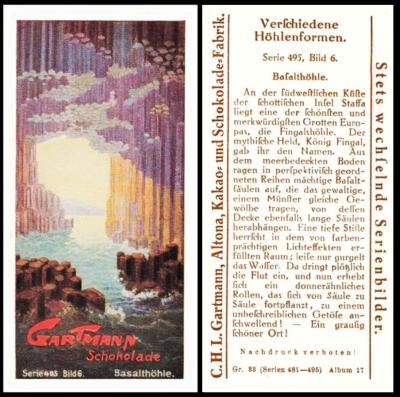
This may seem a very unmusical subject for this week`s theme, but wait, for this is Fingal`s Cave. And that is not just a sea cave on the Island of Staffa, Scotland, but a concert overture by Felix Mendelssohn, written between 1830 and 1832, and published to great acclaim the year after. Most of all it is a piece of music which is usually performed on the last night of the Proms.
The music was inspired by a visit that Mendelssohn made to Scotland, and to Fingal`s Cave, in 1829. He loved it there, the grandeur, and the crashing of the waves. It is said that he had composed most of it before he left Scotland, so eager was he to immortalise his feelings. At first, he called it "Zur einsamen Insel", or "To The Lonely Island" - which begs the question as to whether this was meant as a depiction of his trip, going to the island, or as a tribute, a poem written to the Island with fond remembrance.
As for the title though, the music was not intended to be called Fingal`s Cave at all. For that name, we must blame a German publisher, who produced a slightly later edition of the music and titled it "Fingalshohle" or "Fingal`s Cave". Though, actually, Mendelssohn did use that title on the musical score, so it may have just been a bit of a misunderstanding.
The actual Fingal's Cave is now owned by the National Trust for Scotland, and is part of a nature reserve. It is formed from hexagonal basalt columns and is similar to the Giant`s Causeway.
You can see it on other cards, including card 4 of Cohen, Weenen & Co`s "Wonders of the World" (1923 - gold border, and grey border), where it tells us that "Hundreds of tourists visit this wonderful cave annually, access being from the sea at low tide by boat".
It is also on card 37 of R. J. Lea`s "Wonders of the World (1938), where we are told that "This famous basaltic grotto was discovered by Sir Joseph Banks in the seventeenth century. It is situated on the island of Staffa in the Hebrides and is 230 feet long. Famous for its stalactites the rush of wind through the cave produces a weird musical sound".
And, whilst on the subject of stalagmites, you will also reportedly find it on card 39 of the second series of W.D. & H.O. Wills "Do You Know", though it is not named as Fingal`s Cave, it simply titles the card "Stalactites and Stalagmites". But everyone I have spoken to is certain that this is inside Fingal`s Cave, so it deserves a mention. And more investigation. Given time.
As for why it is called Fingal`s Cave, we can blame the Scottish poet James Macpherson, who created this grandiose legend about a King who lived in a castle that fell through the rock into the sea, and that the columns were all that was left of its construction. I expect that appealed to Mendelssohn too.
To our set, this is part of group 33, which covers series 491 to 495, and this set is the last of those series, 495. The card also tells us that these fit in Album 17. The title "Verschiedene Hohlenformen" actually means "different cave formations" , and it is a very atmospheric set. Oddly, as I translated them, two turned out to be actual caves, so I will have to find out if the others are of actual places too. Ours may actually be Fingal`s Cave.
Anyway the cards in the set, as I now know them, are :
- Die Adelsberger Grotte [an actual cave not a formation - Postojna Cave, Slovenia]
- Krystallhohle [crystal cave]
- Cova des Coloms [an actual cave not a formation - in Mallorca. Spain]
- Eishohle [ice cave]
- Gewolbehohle [vaulted cave]
- Basalthohle [basalt cave]
Thursday, 17th July 2025
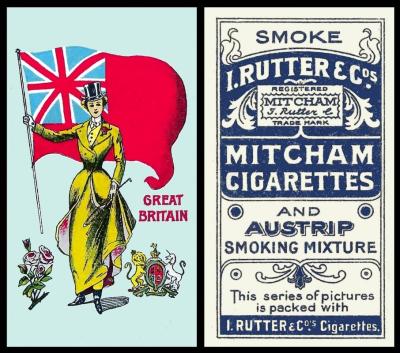
I have been unable to find out when the first Union Jack was waved at the Promenade concerts, but it is a long standing tradition. However, more recently, there have been other flags flown too, most notably that of the European Union, and Ukraine. And, at times, the flag waving gets rather frenetic.
This young lady may be waving a flag, but she looks way too refined to leap in the air - though, if you take a second look, she is only raising the flag in one hand, the other is raising her skirt to show a shapely ankle. In 1900, when this set was issued, this was pretty shocking....
First of all, you can read lots more about Rutter and its story elsewhere on this website - with our card of the day for the 16th of March, 2022.
As for this set it is listed in our original World Tobacco Issues Index as ;
- GIRLS, FLAGS & ARMS OF COUNTRIES (A). Sm. 66 x 36. Unnd. (24). See H.383 ... R66-6
that same text appears in our updated version, but there is a new card code, of R980-400.
As far as the H code, that from the original version of the World Tobacco Issues Index leads you to the handbook published by the London Cigarette Card Company in 1950, where the text reads ;
- H.383. GIRLS, FLAGS & ARMS OF COUNTRIES (adopted title). Fronts per Fig.383 in colour, blue background. Unnumbered series of 24.
Pre-1919 -
Anonymous - plain back
Rutter - dark blue printed back
1. Austria Hungary
2. Belgium
3. Canada
4. China
5. Cuba
6. Denmark
7. France
8. Germany
9. Great Britain
10. Greece
11. Holland
12. Ireland
13. Italy
14. Japan
15. Mexico
16. Norway
17. Portugal
18. Russia
19. Scotland
20. Spain
21. Sweden
22. Switzerland
23. Turkey
24. United States of America.
As far as the retail prices of these cards in 1950, they appear in the catalogue, which is uniform with the handbook, listed as :
24. * Girls, Flags & Arms of Countries ; - H.383
- A. Blue back ... as odds 25/- to 75/- each
- B. Plain back ... no odds available.
It is entirely possible that the plain back version was either a remainder or cards cut down from a printer`s proof sheet, and today you will often see them listed in auctions as "Plain Back Proof"s. It seems to never be suggested, anywhere, that it was an anonymous version issued by another manufacturer, or in another country. And, tellingly, it is tied to Rutter in the London Cigarette Card Company Catalogue.
Friday, 18th July 2025

I close the week with a little tale from a reader, who got in touch and told me that his wife's Uncle Will, who sadly died three years ago, at the grand age of a hundred and six (!), actually used to attend the Promenade concerts, with a little group of eight friends. More than that, he started going when they were still at Queens Hall, in the 1930's, and they continued to attend them at the Royal Albert Hall.
He enjoyed them immensely and had a wealth of little anecdotes. One of his favourites concerned Sir Henry Wood, who was famous for leaving the stage and then coming back for an encore, several times. But those in the know would always know that he would be back again, because only on the final performance of the night would he come out wearing his top hat and cloak. After that it was safe to go home yourself in the certain knowledge he would not return for more.
And my correspondent wondered, if somewhere, out there , is a card that shows him so attired ?
He also tells me another tale, and that is that on the 5th of October, 1938, a special jubilee concert was held at the Royal Albert Hall to celebrate Sir Henry Wood's fifty years as a conductor. Sergei Rachmaninoff agreed to attend, and he performed his Second Piano Concerto. And Uncle Will was there too - he often remembered, and commented on Rachmaninoff being "a tall, thin man who made the piano sing".
My correspondent also wondered if there was any cards of Rachmaninoff. Sadly, though I looked, I only found one, and it is a bit borderline - it is a playing card, issued by Thurston Moore Country Ltd as part of a set called "Composers" in 1982. But he is the Jack of Hearts, which I think would have pleased him.
And when I saw this card, with a very excited piano player, I thought it would appeal to both musicians` obvious sense of humour. Another thing I like about it is that it shows children, and these days the Proms have attempted to attract a more youthful audience, with modern singers and bands, and also involving films and TV.
Doctor Who has been there, several times, in 2008, 2010, 2013, and 2024 - and this year, on the 9th of August, Star Wars will be celebrated - but they have a longer connection with the Proms than that, and first appeared in 1999. I have not yet found an X Files reference, but I really enjoyed the trying to....
Back to cards.
These are a mixture of a black silhouette, to the top, and a coloured artwork beneath. They have a two part title, one below the silhouette and one below the colour picture. And they didn`t make a lot of sense until I realised that the first part of the words beneath the silhouette, namely "Si vous revez..." translated to "if you dream of...." whatever is pictured, the action in the coloured picture will occur. That also saved me typing it out every time, or, more correctly, allowed me to delete the over half of those I had typed.
So far I know of the following, which I am numbering just so that I can close the book when I get eighty four of them. Which I may have done if I had not veered off on the tangent.....
- achat de tableau - vous ferez de la peinture (P)(V)
- aller sur le terrain - fencing match - votre chien sea tres querrelleur (G)
- autruche - ostrich - le plumes vous couteront cher (G)(M)
- balances - scales - justice vous sera rendu (V)
- boulanger - baker - vos ferez des brioches et des pates.
- chardons - thistles - vous serez vainqueur dans les courses d`anes (G)(V)
- chasse a l`ours - hunt a bear - on vous fera cadeau d`une fourrure (G)(V)
- cheveaux de bois - wooden horse - vous serez incorpore dans la cavalerie (G)
- cheveaux de courses - race horses - vous appendrez la victoire d`une cheval Francaise (L)
- chevres - goats - vous serez une grande excursion en montagne (G)
- chiffonnier - chimney sweep - vous serez millionaire (G)
- ciseaux - scissors - vous plaiderez en divorce (G)
- combats de coqs - cockfighting - vous devendriez querrelleur (M)
- corbeaux - crows - les gens de votre quartier feront des cancans (G)
- courses de taureaux - bull fighting - vous aurez des demeles avec la justice (G)(L)
- de cartes - playing cards - vous perdrez aux courses (B)
- de piano - piano - vous aurez une vieagreable et animee (G)
- de truffes - pigs and truffles - vous serex malade par gourmandize (G)
- etre poursuivr par des rats - followed by rats - vos domestiques ruineront votre maison (G)
- scie - wood saw - vous irez au cafe-concert (G)
- serpent - snake - on vous fera cadeau d`un boa
- sorciere - witch - vous aurez des ennuis avec votre concierge (G)
- trapeze - trapeze - vous serez doue d`une grande agilitie (G)
- vacances - holidays - votre proprietaire vous donnera conge (G)
- victoire - victory - votre fils deviendra General (M)(V)
Since starting this we have discovered that they were also issued by other companies, so now we have initials added, namely
- (B) - Chocolat de Bretagne
- (G) - Guerin-Boutron
- (L) - Chocolat Louit
- (M) - Galerie Lamartine, 64 Rue Lamertine 64, Paris [clothing]
- (P) - Cacao Payraud
- (V) - Eau de Vichy
So there you go. There are a few things to tidy, the descriptions from the Trade Indexes and the original Hill book, but by the time I got there I could not fathom out the tiny type. Tomorrow I will be able to. And it will be right!
Anyway that is it for me. I am off to turn in for the night.
I hope that you have card-hunting plans for the weekend and that the rain does not dampen your enthusiasm, nor prevent you taking advantage of them entirely. And if you buy anything that fills your heart with wonder, do share.
See you all next week, same time, same website......
